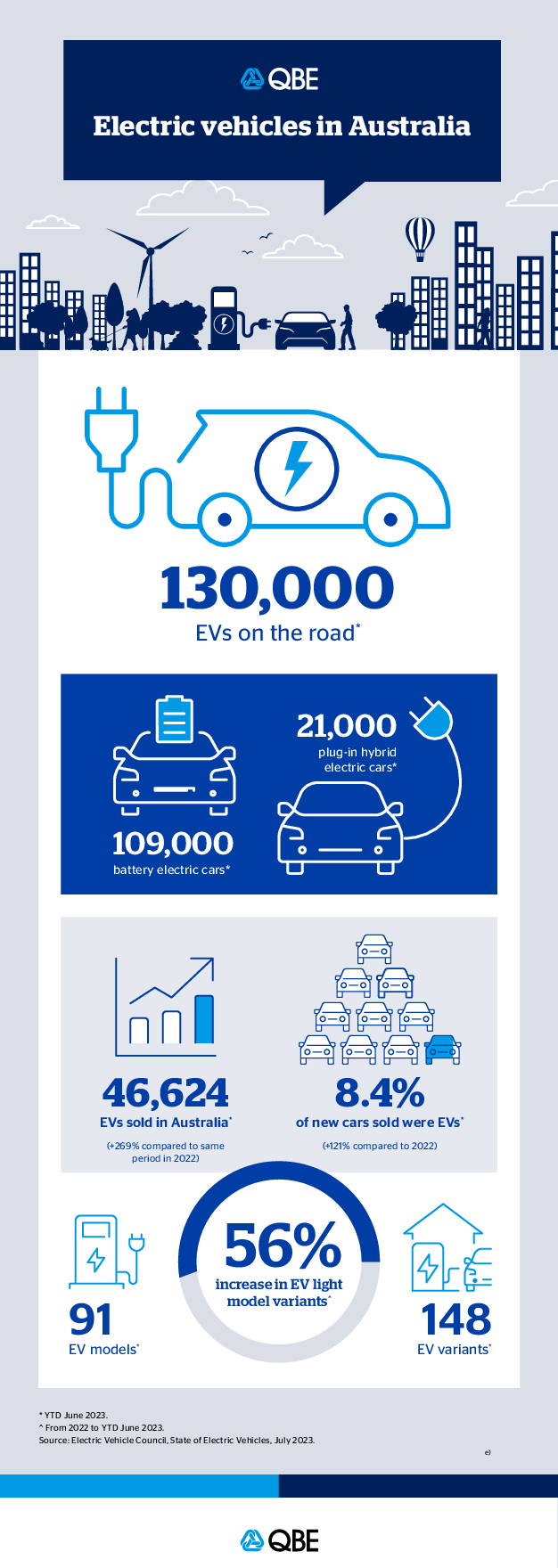The rise of electric vehicles in Australia – managing the risks
- Electric vehicle use is continuing to rise in Australia, despite the geographical challenges involved in developing an accessible charging infrastructure
- With the future of driving veering toward electric vehicles, there are a number of new risks for business and vehicle owners to consider
- Property fires resulting from lithium-ion batteries and exposure to cyber risks through software and data connectivity are just some of the risks drivers and fleet managers should be aware of
As of mid-2023, around 130,000 of the vehicles on Australian roads were electric vehicles (EVs).1
While the number of EVs sold each year continues to increase (8.4% of new vehicles sold were electric in the year to June 2023, compared to 3.8% the year before2), they remain a relatively small percentage of the 21.2 million motor vehicles (excluding caravans, plant equipment, etc) registered in Australia.
Australia’s expansive land size and the significant distances between major cities pose challenges in developing reliable EV charging infrastructure for the country’s drivers.
Access to charging stations is one of the key reasons why, globally, people have been reluctant to purchase EVs. A recent study found that:
- 36% of Australians cited a lack of charging stations as a key concern – higher than the global average of 31%.4
- Long wait times to charge were a concern of 53% of Asia-Pacific respondents,5 while globally, 29% held concerns about the driving range of EVs.6
Charging infrastructure across Australia is expanding though. There has been a year-on-year increase of 57% in high-power charging locations,7 and State, Territory and Federal governments are now funding public fast charging stations.8
Electric vehicle risk considerations
With EV use in Australia on the rise, and as the number of charging points grows, there are a number of risk considerations and insurance implications.
Property fire
Among the various property risks to consider is the risk of fire while vehicles are charging – particularly in enclosed spaces such as underground or multi-storey car parks and garages.
As the take-up of EVs continues to increase, business premises – such as shopping centres, hotels, gyms and hospitals – and stratas – will need to consider the installation of charging points to accommodate employees, customers and tenants.
Charging infrastructure will also be needed for commercial vehicles, such as distribution fleets, and at public transport facilities such as train stations and airports.
A fire can have a devastating effect on a business. EV Fire Safe, with the support of the Australian Government Department of Defence, have developed a range of useful resources to help businesses mitigate risks.
Charger management
Chargers should be installed by a qualified person in compliance with Australian Government Electrical Wiring Rules (AS / NZS 300 Electrical Installations). Charging sites should also be included in block plans and site maintenance schedules, with regular inspections carried out, so any damage can be quickly identified.9
Charger location
When installing a charging point, the physical location needs to be safe and secure to minimise risks associated with unauthorised use, vandalism, or theft. Just as thieves have found new ways to steal keyless cars, there has also been an increase in the theft of car charging cables globally.10
Fires involving lithium-ion batteries tend to be intensive and present unique challenges to firefighters as they can reignite hours – or even days – after initial extinguishment.11 Consideration therefore needs to be given to the possibility of fire spreading to the surroundings, and the equipment needed for the business to safely tackle, or get to safety, should a fire occur.
Cyber risks
Advancements in vehicle and charging station technology have come a long way in recent years and will continue to develop. As vehicles and chargers begin to rely more heavily on software, data connectivity and artificial intelligence, the risk of vulnerability to software glitches, system failure or even malicious cyber-attacks to steal data, cause damage or hold drivers to ransom may also increase.12
Vehicle repair
While some global figures suggest EVs are significantly more expensive to repair than petrol or diesel-powered cars, it may be the case that those figures are skewed by market-leader Tesla.
While Telsas have been found to cost around US$1,350 more to repair after a collision, the figure for non-Tesla EVs was much less at US$269.13
When repairing EVs, there are additional risks caused by their containment and storage of energy. The Australian Standard for Electric vehicle operations – Maintenance and repair contains a safety framework for independent service and repair workshops, including workshop layout, specialised tools, and protection equipment for technicians to safely and efficiently service and repair EVs.
Vulnerable road users
EVs are much quieter than other vehicles and can pose risk to vulnerable road users, such as cyclists and visually impaired pedestrians.14
In 2023, the Federal Government began exploring the need to mandate EVs to include an Acoustic Vehicle Alert System (AVAS).15
In Europe, AVAS has been compulsory on all new types of electric and hybrid vehicles since 1 July 2019, and required on all hybrid or electric vehicles sold since 1 July 2021.16
Driver training
As more businesses explore the introduction of EVs to their fleet, driver training is an important consideration to ensure drivers are familiar with EVs and how to operate them safely.
While a small incident in a conventional car might not be considered a substantial risk for company car drivers, any incident that could lead to battery damage in an EV is a potential fire risk and should be reported and investigated as a priority.
All EV drivers will also benefit from learning about:
- Efficiency tips (for example, switching to eco mode).
- Monitoring their speed, as more energy is consumed at greater speeds.
- Instant acceleration (no manual gears), which can create risk for untrained drivers.
- Regenerative braking, meaning that the vehicle slows down when pressure is removed from the accelerator (unlike the coasting effect in a conventional vehicle). This can affect stopping distances.
- Reading the road ahead to avoid unnecessary acceleration and braking.
Effective driver training can help safer drivers to become more energy efficient, which may lead to reduced costs for their employers.
Managing electric vehicle risks for business
With the new business challenges posed by EVs, it’s important to work with professionals when planning to introduce EVs into a business.
QBE business customers can access a wide range of services, including self-assessment questionnaires and guidance documents to help manage and mitigate risks. To find out more, visit our Fleet Risk Management Solutions page.
Information for electric vehicle owners
Keep an eye out for our additional EV articles to stay informed.
Learn about QBE car insurance and get a quote.
1 Electric Vehicle Council, State of Electric Vehicles report – July 2023
2 Electric Vehicle Council, State of Electric Vehicles report – July 2023
3 Bureau of Infrastructure and Transport Research Economics Statistical Report: Road Vehicles Australia – January 2023
4 EY Mobility Consumer Index (MCI) – 2023 Study
5 EY Mobility Consumer Index (MCI) – 2023 Study
6 EY Mobility Consumer Index (MCI) – 2023 Study
7 Electric Vehicle Council, State of Electric Vehicles report – July 2023
8 Australian Government, Green Vehicle Guide – Electric Vehicles
9 ABCB Electric Vehicles in Buildings – Advisory Notice
10 Recycling Today article – EV charging cables latest metals theft target
11 UNSW Sydney article – Seven things you need to know about lithium-ion battery safety
12 OSTI – Cybersecurity for Electric Vehicle Charging Infrastructure
13 Automotive News article – Tesla crash repairs costs and comparisons
14 Vision Australia report – The impact of electric / hybrid vehicles and bicycles on pedestrians who are blind or have low vision
15 Australian Government – Acoustic Vehicle Alerting Systems for Electric Vehicles
16 European Commission Press Release – Electric and hybrid cars: new rules on noise emitting to protect vulnerable road users











